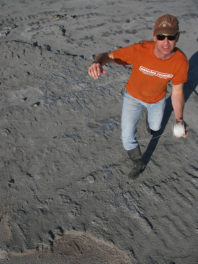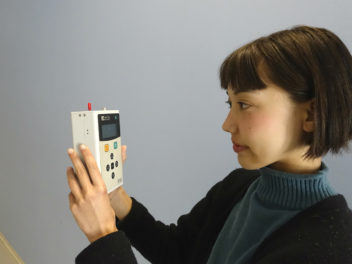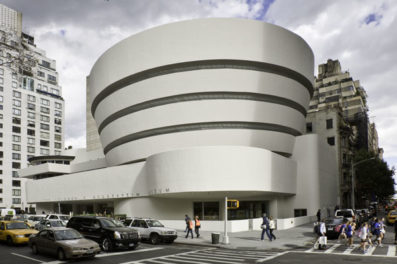At China’s Dunhuang Academy, generations of artists have replicated more than 2,000 works of wall painting and more than 50 polychrome statues from the cave temples of Mogao.
Engaging in the time-honored Chinese artistic practice of replication, these painters enter into the inner world of their ancient forebears, seeking to reconstruct not only the object, but also the original creative process.
In this excerpt from the essay “Wall Painting Replication at Dunhuang: A Personal Account of Its History and Technique” in the Getty Publications book Cave Temples of Dunhuang: Buddhist Art on China’s Silk Road, artist Lou Jie from the Dunhuang Academy reflects on her three decades of work and how it feels to carry on this tradition. Replicas of three Dunhuang cave temples were on view at the Getty earlier this year, and while the exhibition has closed, the book lives on. —Ed.
A colleague working in a fourth-century cave once accidentally discovered a fingerprint impressed in a wall painting. Apparently left by a painter who unintentionally touched a newly constructed wall before it had completely dried, the fingerprint was then covered up by pigments, through which the pattern remained visible. Based on the date of the cave and its painting style, we surmised that this print may have been left by a master from the Western Regions (Xiyu), or even beyond.
In that moment it was as though the cave had become filled with this artist’s breath, an ineffably moving and warm experience. This atmosphere has been the setting for my thirty years as a wall painting copyist. With my face to the wall in the dark silence of the cave, stroke by stroke and painting by painting, I have often felt as though I were in direct dialogue with ancient masters. As my copying practice deepened, I was gradually immersed in the wall paintings, finally becoming completely submerged in the virtuosity and artistic spirit of the original works. In this state of submersion, I transitioned through the mental states of self (wo), self-forgetting (wangwo), and no-self (wuwo), transported as I worked to a world of more than a millennium ago.
At the technical level, though I have gained familiarity with the process of copying, each time I confront a new composition I feel a mixture of apprehension, excitement, and anticipation. My greatest interest is in the parts of the mural that allow me to capture, from fine details, the painter’s unique personality. In the standardized practice of religious painting, often even in the parts of a cave painted in the same era, it is impossible to conceal the distinct presences of different artists because of their highly personalized expressiveness in coloration and line.

Applying pigment to mulberry paper on a replica wall painting to bring two figures to vivid life. Image courtesy of the Dunhuang Academy

Tracing outlines using back lighting. Image courtesy of the Dunhuang Academy
The divinity of the Buddha and the bodhisattvas’ brilliant manifestation of human qualities are infectious in their vitality, allowing a profound appreciation of the painter’s blending of faith and talent with the brush and the piety with which this was offered to the Buddha. Realizing this has given me spiritual guidance in each work of replication and has been of the utmost significance for understanding the style and feeling of the total wall painting.
The copyists who work in the fine arts department of the Dunhuang Academy have all graduated from major institutes of fine art in China. Initially, most arrive here as pilgrims, motivated by a resolve to become artists in their own right. But we soon discover that the paintings and statues at Mogao, relics of earlier times and cultures, are our partners. In the first few years of researching and replicating premodern wall paintings and polychrome statues, quite a few of us work in a passive state, entering into the vocation only gradually.

Duan Wenjie, who was an accomplished painter as well as the second director of what became the Dunhuang Academy, copying wall paintings in the 1950s. Image courtesy of the Dunhuang Academy
I myself was like this. Along with the intensification of research, one is slowly affected by the special training this work provides and influenced by the atmosphere in the grottoes. In addition to developing awareness of the significance of the work, one obtains a unique aesthetic orientation and attitude toward life.
Over the long course of our copying careers, my colleagues and I have also persevered in our own artistic endeavors. As we do so, the special surface feeling and texture of these premodern murals has been a frequent source of inspiration and stimulation, allowing us to put the experiences and techniques gleaned from replication into our own works. Replication leads to original artistic creation, and artistic creation prompts the intensification of replication practice. In this way, replication becomes for us a joyful task rich in exploration and discovery. Our team of replication artists, meanwhile, has become a unique artistic community that itself cannot be reproduced.
Of course, the copyists currently working in the fine arts department have received rigorous training in modeling and coloration. From the perspective of painting skill, most have accumulated enough experience to produce replicas that in terms of representational effects are on a par with the original works. To capture the original works’ spirit, however, is another matter, and not easy to achieve.

An artist captures the outlines of a wall painting in painstaking detail before the addition of color can begin. Image courtesy of the Dunhuang Academy
In the larger world of artistic production, copying is frequently regarded as unoriginal mimicry and often criticized if not dismissed outright. Owing in large part to the very nature of Chinese painting, however, copying is an important educational method for mastering the body of laws governing the Chinese painting tradition. Moreover, it is precisely because of copying that Dunhuang, a once-forgotten treasury of Buddhist art, has become known to the world. Its brilliance, made visible once again through replicas, has become a celebrated component of humankind’s cultural heritage.
Translated from the Chinese by Michelle McCoy.

See all posts in this series »






Very intresting article